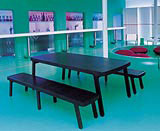Cocktail culture
Bar and Club Design by Bethan Ryder features a collection of design-led drinking dens from across the world. Sara Manuelli takes a look through it

As a veteran barfly I know a good bar when I see it. So I welcomed publisher Laurence King’s new book, Bar and Club Design, since this is a field in which interior schemes often have a short life and a rapid turnover rate, so it’s handy to have a visual record before they shut down or change. The book’s selection is admirably international and divided into bars and restaurant bars, hotel bars and clubs, in many ways a wish list of where to spend your precious leisure time.
Talking of short lives, the Absolut Icebar is recreated annually since 1989 as part of the Icehotel in Swedish Lapland, a construction made of crystal-clear ice from the nearby river Torne. The bar is essentially an ice dome where thick reindeer skins are supposed to comfort you as you drink your glacial vodka out of shot glasses made of blocks of ice.
For those lounge lizards who prefer warmer climes and polychromatic surroundings, the Red Sea restaurant and bar in Eilat, Israel, is an underwater experience located 6m below sea level, with jellyfish-like stools, anemone-shaped lights, curvy lines and 62 windows with a panoramic view of the sea life below. It’s fun, kitsch and the perfect place in which to get drunk, although I definitely would have a problem eating fish while staring its companions in the eyes.
Michael Young’s Astro bar in Iceland is also featured, with his signature soft, curvaceous shapes and candy neon colours. A word of advice was maybe needed in the text that the bar is now defunct, and that with the current economic downturn which so far has affected a few high-profile restaurants, that may be the case for other haunts.
Still, the introduction is a good anthropological overview of our vices across countries and history, highlighting how contemporary bars owe more to the glitzy heritage of cocktail life in 1940s America than our humbler UK pubs. It covers the 1980s design craze, the Ian Schrager/ Philippe Starck phenomenon as well as the ubiquitous ‘make-over’ effect of bars in quaint establishments, as demonstrated by prolific designer David Collins.
Extensive quotes from Sheryl Garratt’s book on club culture remind us that the best places, like the mythical Paradise Garage and The Loft in New York, were often the barest in terms of design too, as they were housed in former industrial spaces such as warehouses and power stations. Ben Kelly’s designs for The Haçienda in Manchester and Lynn Davies’ for the Ministry of Sound in London also picked up on the industrial look in the 1980s, turning the ‘bare box’ format into the norm. The rise of the louche, cocktail lounge culture is also charted, with smaller membership clubs like Chinawhite thriving on celebrity culture, bad behaviour and decadent design.
Overall, the book is a carefully researched selection of stunning design-led venues – the ultimate coffee table book to glance at lazily and spill your drink on. Maybe the text accompanying the images could have been a bit more intriguing since it often reads as neat, but sterile, description of the interiors features, while experience tells us that bars are full of life, laughter and noise, containers and backdrops to people’s dramas, celebrations and, indeed, drinking habits.
Bar and Club Design by Bethan Ryder is published by Laurence King on 25 February, priced £35
-
Post a comment




